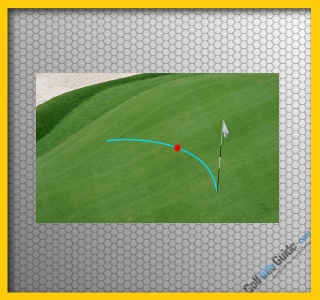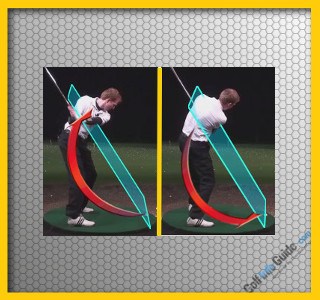Golf is one of the hardest games in the world – on that point, there can be little debate. It is extremely difficult to hit long and straight golf shots, even if you are standing on the driving range with no pressure and nothing on the line. The physical demands of hitting good golf shots are significant, as you have to put the club face in a square position on the back of the ball even as the club head is moving as fast as 100 MPH or more. If the only challenges you faced on the golf course were physical in nature, this would still be a very difficult game to conquer.
Of course, as a golfer, you already know that there is more to this game than just the physical side of the equation. There is a huge mental component to the game of golf as well, and many would argue that the mental challenges you face on the course are actually the biggest hurdle of all. You need to have a solid swing and a good short game to play well, of course, but it is the mental game that usually separates the best golfers from the rest of the pack.
If you are like most amateur golfers, you likely spend plenty of time trying to improve on the physical side of your game – yet you rarely, if ever, think about how you are going to improve from a mental standpoint. Unfortunately, the failure to work on the mental game is a big part of the reason why most amateur golfers never really make much improvement over time. To change that pattern, consider putting the following list of mental game tips to use.

#1 – Avoiding Penalty Shots is Priority #1
This first tip probably seems like an obvious point, but most golfers throw this line of thinking out the window when making decisions on the course. With each shot that you face during a round of golf, you have a number of possibilities in front of you. There are probably at least a couple of different clubs you can pick from, and there are certainly a variety of target lines available as well. As the golfer, it is your job to pick the right combination of club and target line to leave your ball in a good spot for the next shot. This skill is often called course management, and it is one of the keys to posting good scores.
A big part of your course management approach should be a commitment to keeping penalty strokes off of your scorecard. To do so, you are going to want to make conservative choices more often than not. For example, if you aren’t sure you can carry a water hazard that is guarding the front of a green, you can play away from that hazard in order to keep your ball on the grass (and out of the water). Sure, you aren’t going to hit very many incredible shots this way, but you are going to stay away from penalties and you are going to keep your score on track.
The average golfer is tempted by trying to pull off an amazing shot too frequently, and those attempts often lead to penalty strokes being added to the card. You can play aggressive from time to time, but you need to pick spots where the penalty for missing is not going to be too severe. Most of the time, you will be best-served by a conservative game plan that leaves you ball safely in play.

#2 – Each Hole Is a New Challenge
Without a doubt, this is one of the toughest mental tips to actually put into action in your game. It is hard to see each hole as a new challenge, since you are always thinking about how your score is going to add up at the end of the day. However, in order to avoid having your emotions and frustrations lead to a string of bad holes, you do need to find a way to ‘reset’ when you step onto each tee box.
Golf is a hard game, and you are bound to make mistakes along the way during any given round. There has never been a ‘perfect’ round of golf played in the history of the game, and that mythical perfect round isn’t going to happen anytime soon, either. Every round you play will be made up of good and bad shots, and it is your job to ride out the roller coaster while remaining as focused and positive as possible.
Using the start of a new hole as an opportunity to reset your mind is a great way to think about the mental game. When you walk onto the next tee, take a moment to collect your thoughts, take a deep breath, and start thinking about how you are going to conquer the hole in front of you. There is nothing you can do about the shots that have already been hit, so you might as well do your best on the shots to come.

When you get on the greens – especially when you are close to the hole – it is tempting to do what you can to ‘force’ the ball into the cup. You will often hear golfers say that they ‘can’t’ miss a given putt, often when they are inside of a few feet away. However, no matter how easy you might think a putt should be, or how important it is to your score, there is nothing you can do to force the ball to fall in.
Instead of forcing the action, you should always do your best to simply roll the ball toward the hole. What does that mean? Mentally, you are going to focus on what you control, which is the mechanics of your stroke, rather than thinking about whether or not the ball is going to go in. You don’t actually control the end result, because there is a lot that can happen between the face of your putter and the edge of the cup. A bad bounce or a surprising change in speed can throw your putt off line, even if you make a great stroke. By accepting the fact that you don’t have total control over your putts, your mind will be freed up to simply make a great stroke while hoping for a positive outcome.

One of the best things about playing the game of golf is having the opportunity to spend time playing with other golfers. There is a lot of downtime during the average round of golf, so having some enjoyable playing partners to chat with along the way is a nice bonus. However, while it is fun to play with others, you should not allow those other golfers to influence the way you approach your game.
It is common for amateur golfers to fall into the trap of trying to ‘keep up’ with the other players in their group. For instance, if you are playing with someone who is consistently out driving you, it might be tempting to swing harder off the tee to push your ball out there a bit farther. Of course, making that change is almost certainly going to cause problems in your game, and you may not play up to your potential as a result.
Getting out of the game you usually play is something that you should try to avoid at all costs. There is nothing wrong with admiring a player in your group who can blast the ball from the tee, but that doesn’t mean you should change your own game plan in an attempt to keep up. Be yourself on the course, stick with what you do best, and be proud of your game at the end of the round.

If you are like most golfers, you probably head out onto the course with a specific number in mind as a goal score for the day. If you are a relatively good golfer, you might set out with the hopes of breaking 80. Or, if you are less experienced, simply keeping your score under 100 might be seen as an accomplishment. Whatever the case, there is nothing wrong with having a goal to keep your motivated and focused on the task at hand.
However, while you can go ahead and make those goals, you want to mostly put them out of your mind when playing. If you are thinking too much about shooting one specific score, it is easy to add stress to your game unnecessarily. For example, if your goal is to break 80, you will know that you can’t shoot more than seven-over-par (on a par-72 golf course). So, if you make a couple of early bogeys, you might start to count up those bogeys and put more and more pressure on yourself to avoid mistakes.
This kind of thinking is especially dangerous on the putting green, where you can see the opportunity to save a stroke right in front of you. The difference between making and missing a short putt is one stroke, of course, and that might be the stroke that pushes you over your goal for the day. It is hard to putt well when you thinking about what each individual putt means for you overall score, so set those concerns aside and just do your best to make a great stroke.

#6 – Leave Your Driver in the Bag
For some golfers, club selection is automatic when they arrive at the tee of a par four or five – they reach for the driver, tee the ball up high, and let it fly. While it is fun to hit the ball as far as possible with your driver, there are likely some holes on your local course that would be better conquered through the use of a shorter club on the tee. When you face a narrow par four or par five where accuracy is going to be more important than distance, keep your driver in the bag and choose a three wood, hybrid club, or even a long iron.
When trying to decide what club to use from the tee, one of the best things you can do is think about the hole in reverse. Imagine where you would like to play your approach shot from, and then think about which of your clubs is going to put your ball in that spot. Do you need your driver to set up a reasonable approach, or will a shorter club do the job? Remember, the goal at the end of the day is to shoot the lowest possible score – and the clubs that will help you reach that goal are the ones you should use.

Chipping is an area of the game that is notoriously difficult for amateur players. Many players don’t spend enough time practicing their chipping technique, and those who do practice frequently struggle to make progress. One of the things you can do to finally make a breakthrough in your chipping game is to use a target ‘spot’ to focus on as you swing.
Before hitting any chip shot, take a look at the path your ball is going to need to take in order to reach the hole. Then, after reading the whole chip shot, pick out a very specific spot that you will attempt to land the ball on when you pitch it onto the putting surface. This landing spot should be in a place where it allows the ball to bounce and roll out to the cup perfectly. Once you have selected your landing spot, you can forget about the hole itself and focus in on the task of sending the ball to that spot on the fly.
There are a number of benefits to be enjoyed when you decide to chip to a spot. First, you will have had to invest some time in reading your chip in order to pick a spot, so you will already be more-prepared than most amateur golfers. Also, using the spot technique is a great way to give yourself some clarity and purpose as you swing the club. When you chip without having a spot in mind, your stroke may be tentative as you try to ‘guide’ the ball up to the hole. Golf is a target game, and picking a spot will provide you with a very specific target to use. Work on mastering this technique in practice and it will serve you well out on the course.

It is hard to keep your patience on the golf course. There are plenty of opportunities to get frustrated during a round of golf, and you can’t exactly make up for your mistakes quickly. After all, you are only going to finish one hole every fifteen minutes or so, meaning a bad hole is going to have plenty of time to linger in the back of your mind before you can get yourself on track once again. However, if you are going to reach your goals on the course, you need to master the art of remaining patient while remembering that 18 holes is plenty of time to make up for early mistakes.
Many golfers allow their first few holes to dictate the course of the entire round. If they get off to a bad start, some players will just assume they are having an ‘off day’. That is a mistake, of course, as you can always get things turned around as long as you keep giving a full effort. By being as patient as possible and focusing on performing your best on each and every shot, you should be able to set aside the temporary frustrations that are bound to pop up along the way.
There are few things quite as exciting on the golf course as rallying with a few great holes at the end of your round to save a good score for the day – but you can only know that feeling if you are willing to stick with it through a rough start. Don’t give up on yourself just because you don’t get out of the gate on the right foot. Do your best to ‘steady the ship’ in the early holes and you will still have time to hit some excellent shots before the round has concluded.

Golf is an easier game when it is played uphill. That is a statement that is true in nearly all cases, which is why a big part of your course management strategy should come down to trying to find the low side of the hole. When looking at the shot in front of you, do your best to find a way to favor the low side, so you can play your next shot up toward the cup. Whether pitching, chipping, or putting, you will almost always be better off if you are below the hole.
Why is it so much easier to play uphill? Simple – distance control. The biggest challenge that you face in the short game is controlling the distance of your shots, and it is always going to be easier to handle that task when you get to play uphill. Downhill shots, especially on firm and fast surfaces, tend to run away from you when hit just a fraction too hard. That is not going to happen when coming back up a slope. The ball will stop quicker when you play uphill, of course, meaning you will have a greater margin for error.
It will even be worth the sacrifice to remain below the hole if you have to leave your ball farther away from the target on an approach shot. For instance, if you were given the option of having a downhill five-foot putt or an uphill ten-foot putt, you would probably want to take the ten-footer more often than not (when the greens are fast, specifically). So, your planning for approach shots doesn’t need to always come down to getting the ball as close to the hole as possible. As long as you are under the hole, playing from a bit farther away is really no big deal at all.

At the end of the day, this is a game, and it should be fun each and every time you put the tee into the ground. If you aren’t having fun when you head to the course, you really should find something else to do. Golf is meant to be a diversion and a distraction from your day to day life, which is likely filled with work and other obligations. In exchange for the time and money you invest in the game, you should at least come away feeling like you have had a great time.
Of course, people who are serious about their scores often bristle at the idea that they should be focused on fun above all else. However, those two objectives don’t have to be mutually exclusive – you can focus on fun while also trying to play at a high level. In fact, it could be argued that you will actually play better when you are more concerned with having fun than you are with posting a low number. It is hard to play well when you are trying too hard, so relax, focus on fun, and watch your scores fall at the same time.
Your mind can either be your greatest ally or your biggest impediment on the golf course. When you think the right way during your rounds, you will find that the game suddenly seems a bit easier. On the other hand, making poor decisions and having the wrong attitude can take a hard game and make it suddenly impossible. Hopefully the tips listed above will help you to perform at your best from a mental standpoint during all of your upcoming rounds – good luck!






